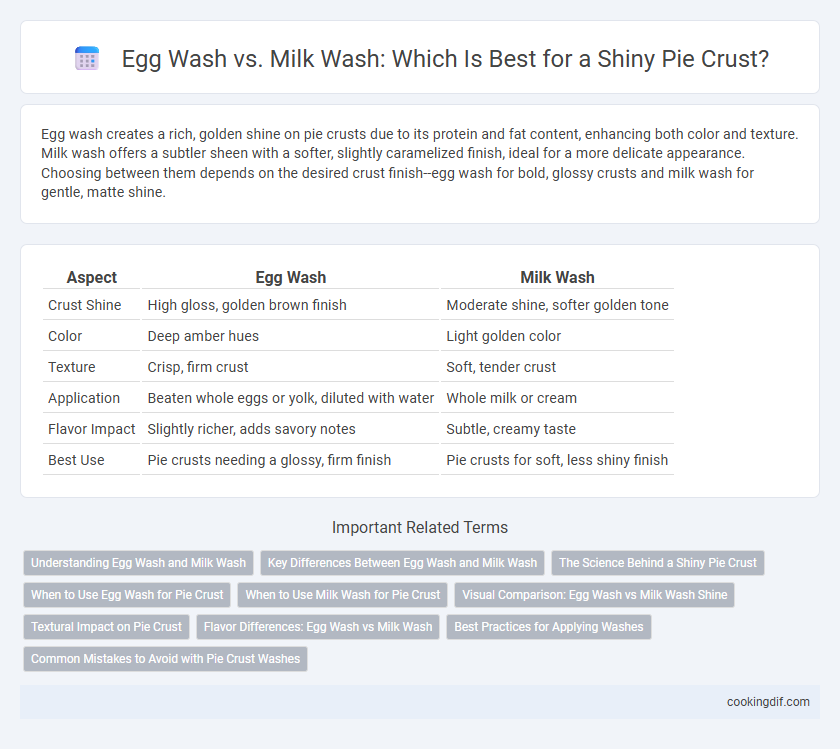Egg wash creates a rich, golden shine on pie crusts due to its protein and fat content, enhancing both color and texture. Milk wash offers a subtler sheen with a softer, slightly caramelized finish, ideal for a more delicate appearance. Choosing between them depends on the desired crust finish--egg wash for bold, glossy crusts and milk wash for gentle, matte shine.
Table of Comparison
| Aspect | Egg Wash | Milk Wash |
|---|---|---|
| Crust Shine | High gloss, golden brown finish | Moderate shine, softer golden tone |
| Color | Deep amber hues | Light golden color |
| Texture | Crisp, firm crust | Soft, tender crust |
| Application | Beaten whole eggs or yolk, diluted with water | Whole milk or cream |
| Flavor Impact | Slightly richer, adds savory notes | Subtle, creamy taste |
| Best Use | Pie crusts needing a glossy, firm finish | Pie crusts for soft, less shiny finish |
Understanding Egg Wash and Milk Wash
Egg wash, composed of beaten eggs sometimes mixed with water or cream, creates a rich, golden, and glossy crust by enhancing browning through its protein and fat content. Milk wash, typically whole or skim milk applied before baking, imparts a softer sheen with a subtle browning effect due to its natural sugars and proteins. Selecting egg wash results in a shiny, crisp finish ideal for savory pies, while milk wash produces a gentler, matte glaze suited for tender pastry crusts.
Key Differences Between Egg Wash and Milk Wash
Egg wash creates a glossy, golden crust due to the protein and fat content that promotes browning, whereas milk wash results in a softer, matte finish with a slight creaminess. Egg wash enhances crispiness and gives a more vibrant sheen, ideal for decorative pies, while milk wash provides a subtler shine and tender texture suitable for rustic pies. The choice depends on the desired crust appearance and texture, with egg wash offering a more pronounced shine and milk wash producing a gentle, warm glow.
The Science Behind a Shiny Pie Crust
Egg wash contains proteins and fats that coagulate and caramelize under heat, creating a glossy, golden-brown finish on pie crusts. Milk wash, rich in lactose and proteins, promotes browning but results in a softer, less reflective shine compared to egg wash. The Maillard reaction, driven by amino acids in egg wash, enhances crust color and texture, while milk's sugars primarily contribute to browning through caramelization.
When to Use Egg Wash for Pie Crust
Egg wash enhances pie crust shine with a rich golden color and crisp texture, ideal for fruit pies and savory pies requiring a glossy finish. Use egg wash when a deep, vibrant shine is desired, especially for lattice and decorative crusts, as it browns evenly and seals edges effectively. Avoid egg wash on delicate or sweet crusts where a softer, matte finish from milk wash is preferred to maintain a tender bite.
When to Use Milk Wash for Pie Crust
Milk wash is ideal for pie crusts when aiming for a subtle, golden-brown shine with a slightly softer texture. It enhances browning while maintaining a tender crust, making it perfect for fruit pies or custard-based fillings where a delicate finish complements the flavor. Using milk wash avoids the intense glossiness and firmness that egg wash can produce, ensuring a visually appealing yet tender pie crust.
Visual Comparison: Egg Wash vs Milk Wash Shine
Egg wash creates a rich, golden-brown crust with a glossy finish, enhancing the pie's visual appeal through its vibrant sheen and deeper color contrast. Milk wash produces a softer, matte shine with a lighter golden tone, offering a subtler and more natural crust appearance. The choice between egg wash and milk wash significantly impacts the pie's surface texture and color intensity, influencing overall presentation quality.
Textural Impact on Pie Crust
Egg wash creates a glossy, golden-brown crust with a slightly crisp texture due to the protein and fat content in the eggs, enhancing both appearance and crunch. Milk wash produces a softer, less shiny crust with a subtle browning effect, contributing to a tender and flaky texture. Choosing egg wash or milk wash significantly influences the pie crust's final texture, with eggs providing firmness and milk offering softness.
Flavor Differences: Egg Wash vs Milk Wash
Egg wash enhances pie crust shine with a rich, golden hue and imparts a slightly savory flavor due to the proteins in eggs, creating a more complex taste profile. Milk wash yields a softer, less glossy crust while adding subtle sweetness and moisture, complementing lighter or fruit-filled pies. The choice between egg wash and milk wash directly influences both the visual appeal and flavor depth of the pie crust.
Best Practices for Applying Washes
Applying egg wash creates a glossy, deep golden crust by combining beaten eggs with water or milk, making it ideal for achieving a professional bakery finish on pie crusts. Milk wash results in a softer, more matte shine and contributes to a tender crust texture, suitable for rustic-style pies. For best results, use a pastry brush to apply an even, thin layer just before baking, avoiding excessive liquid to prevent sogginess and ensuring the crust bakes evenly.
Common Mistakes to Avoid with Pie Crust Washes
Applying egg wash or milk wash improperly can lead to uneven browning and a patchy, unattractive pie crust shine. A common mistake is using too much wash, causing sogginess, or too little, resulting in a dull finish. Avoid these errors by brushing a thin, even layer and choosing the right wash based on the desired golden color and glossiness.
Egg wash vs milk wash for crust shine Infographic

 cookingdif.com
cookingdif.com